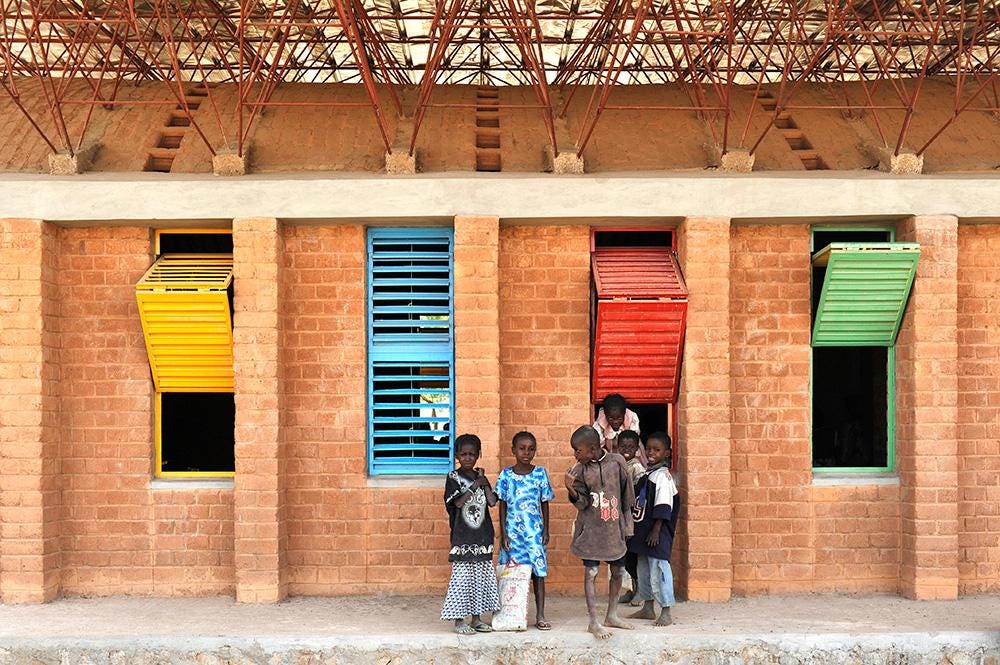First Black winner of the Pritzker Architecture Prize
Diébédo Francis Kéré
Introduction: Francis Kéré, a visionary architect born in the small village of Gando in Burkina Faso, has emerged as a transformative force in architecture. His innovative designs, deeply rooted in sustainability and community engagement, have garnered international acclaim and become symbols of hope and progress. From his humble beginnings in West Africa to receiving the prestigious Pritzker Architecture Prize, Kéré's journey is a testament to the power of architecture to address social, cultural, and environmental challenges.
Early Life and Education: Francis Kéré was born on April 10, 1965, in Gando, a village without electricity or running water. Growing up in a community with limited resources fueled his early interest in finding creative solutions to improve living conditions. Kéré's journey into architecture began when he received a scholarship to attend the Technical University of Berlin in Germany.
While studying at the university, Kéré's perspective on architecture underwent a profound transformation. Inspired by his experiences in Burkina Faso, he began to question conventional architectural practices that often overlooked the needs of marginalized communities—this period of self-discovery laid the foundation for his future endeavors.
Return to Burkina Faso: Upon completing his studies, Kéré faced a pivotal decision: to remain in Germany or return to Burkina Faso. Driven by a deep sense of responsibility to contribute to the development of his homeland, he chose the latter. In 2001, he founded the Kéré Architecture firm with a mission to create sustainable, community-focused designs that address the unique challenges faced by the people of Burkina Faso.
One of his earliest and most impactful projects was the Gando Primary School (photo by Erik-Jan Ouwerkerk). The school, completed in 2001, showcased Kéré's commitment to merging traditional building techniques with modern architectural principles. It employed local materials and construction methods, empowering the community to participate in the construction process actively. The success of the Gando Primary School marked the beginning of Kéré's reputation as a socially conscious architect.
Innovations in Sustainable Design: Francis Kéré's architectural philosophy is deeply rooted in sustainability, embracing both environmental and social dimensions. His designs often feature natural ventilation, passive cooling techniques, and the use of local materials, showcasing an intimate understanding of the local climate and context. He integrates traditional building methods with contemporary design principles, creating aesthetically striking and environmentally responsible structures.
His commitment to sustainability extends beyond the construction phase. Kéré prioritizes projects that empower local communities economically, socially, and culturally. By involving residents in the construction process and using locally sourced materials, he minimizes the environmental impact and contributes to the economic development of the communities he serves.
Architectural Achievements: Over the years, Francis Kéré's portfolio has expanded to include a diverse range of global projects. In addition to educational buildings, he has designed cultural institutions, public spaces, and residential structures. His notable works include the Opera Village in Laongo, Burkina Faso, the Léo Surgical Clinic & Health Center, and the Serpentine Pavilion in London.
The Serpentine Pavilion, unveiled in 2017, marked a significant milestone in Kéré's career: his design, a blue triangular structure with a central oculus, celebrated simplicity, and functionality. The pavilion served as a gathering space for cultural events and community engagement, embodying Kéré's belief that architecture should foster inclusivity and interaction.
Recognition and Awards: In 2017, Francis Kéré's contributions to architecture were globally recognized when he was awarded the Serpentine Pavilion Commission. The same year, he received the Arnold W. Brunner Memorial Prize from the American Academy of Arts and Letters. However, the pinnacle of his career came in 2022 when he was awarded the prestigious Pritzker Architecture Prize.
The Pritzker Prize, often regarded as the Nobel Prize of architecture, celebrated Kéré for his groundbreaking work in creating socially responsive and environmentally sustainable designs. The jury commended his ability to "transcend borders and transform lives" through architecture. The award not only brought international attention to Kéré's work but also elevated the conversation around the role of architects in addressing global challenges.
Legacy and Impact: Francis Kéré's legacy extends beyond his designed physical structures. His impact on the field of architecture lies in his ability to challenge norms, question conventions, and redefine the architect's role in society. Kéré has inspired a new generation of architects to consider the broader implications of their designs through his emphasis on community engagement, sustainability, and cultural sensitivity.
In Burkina Faso, Kéré's influence is palpable. The Gando Primary School, his first significant project, stands as a building and a symbol of empowerment, education, and community resilience. The Opera Village, with its fusion of traditional Burkinabé architecture and contemporary design, is a testament to the harmonious coexistence of the old and the new.
Beyond Burkina Faso, Kéré's impact resonates in projects like the Serpentine Pavilion, which brought his vision of accessible and inclusive public spaces to an international audience. His commitment to sustainability and social responsibility has set a standard for architects worldwide, urging them to consider the ethical dimensions of their practice.
Conclusion: Francis Kéré's journey from a small village in Burkina Faso to receiving the Pritzker Architecture Prize encapsulates a narrative of resilience, innovation, and dedication to community upliftment. His architecture is not merely about creating buildings but about fostering connections, bridging cultures, and addressing the pressing challenges of our time. As he continues to shape sustainable futures through his visionary designs, Francis Kéré remains a beacon of inspiration for architects and changemakers worldwide.



